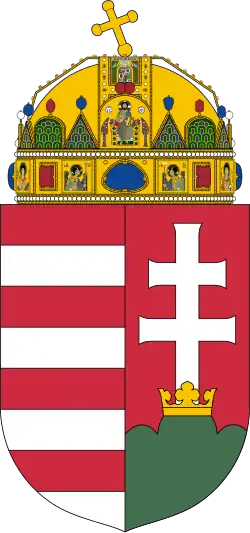1935 Hungarian parliamentary election|
|
|
|
|
First party
|
Second party
|
|
|
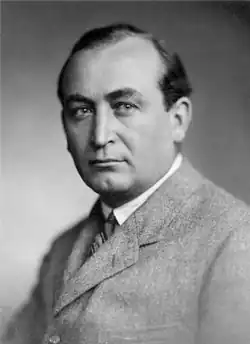
|
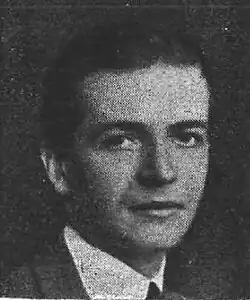
|
| Leader
|
Gyula Gömbös
|
Tibor Eckhardt
|
| Party
|
NEP
|
FKgP
|
| Seats won
|
164
|
22
|
| Popular vote
|
879,474
|
387,351
|
| Percentage
|
44.55%
|
19.62%
|
|
|
|
Third party
|
Fourth party
|
|
|
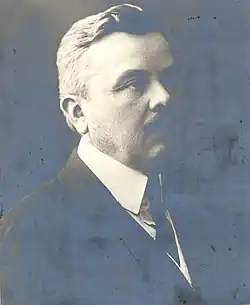
|

|
| Leader
|
János Zichy
|
Károly Peyer
|
| Party
|
KGSZP
|
MSZDP
|
| Seats won
|
14
|
11
|
| Popular vote
|
175,165
|
132,052
|
| Percentage
|
8.87%
|
6.69%
|
|
|
Parliamentary elections were held in Hungary between 31 March and 7 April 1935.[1] The result was a victory for the Party of National Unity, which won 164 of the 245 seats in Parliament. Gyula Gömbös remained Prime Minister.[2]
Electoral system
The electoral system remained the same as in 1931. There were 199 openly elected single-member constituencies and 11 secretly elected multi-member constituencies electing a total of 46 seats.[3][4]
Parties and leaders
Results
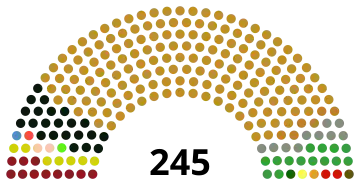 |
|---|
| Party | Votes | % | Seats | +/– |
|---|
| Party of National Unity | 879,474 | 44.55 | 164 | +15 |
| Independent Smallholders Party | 387,351 | 19.62 | 22 | +12 |
| Christian Economic and Social Party | 175,165 | 8.87 | 14 | –18 |
| Social Democratic Party of Hungary | 132,052 | 6.69 | 11 | –3 |
| Hungarian National Socialist Party | 75,318 | 3.82 | 2 | New |
| Liberal and Democratic Opposition (ESZDP–NDP) | 72,407 | 3.67 | 7 | +1 |
| Unofficial Party of National Unity candidates | 56,249 | 2.85 | 6 | –2 |
| National Legitimist Party | 40,025 | 2.03 | 1 | New |
| National Radical Party[a] | 17,031 | 0.86 | 0 | –1 |
| Reform Generation | 14,478 | 0.73 | 2 | New |
| Hungarian Agricultural Labourers and Workers Party | 11,004 | 0.56 | 1 | +1 |
| Christian Opposition | 9,151 | 0.46 | 1 | –1 |
| Christian National Front | 8,526 | 0.43 | 1 | New |
| Party of National Will | 7,431 | 0.38 | 1 | New |
| Party of Independence and '48[a] | 5,648 | 0.29 | 1 | +1 |
| National Agrarian Opposition | 5,320 | 0.27 | 1 | 0 |
| Free Civic Party | 2,527 | 0.13 | 0 | New |
| Unified National Party of Workers and Lower Middle Class | 915 | 0.05 | 0 | New |
| Hungarian Truth Party | 546 | 0.03 | 0 | New |
| Independents | 73,471 | 3.72 | 10 | –6 |
| Total | 1,974,089 | 100.00 | 245 | 0 |
|
| Registered voters/turnout | 2,475,214 | – | |
|---|
| Source: Nohlen & Stöver |
The total number of registered voters was 3,005,742, but only 2,475,214 were in contested constituencies.[3]
By constituency type
| Party | SMCs[b] | MMCs[c] | Total
seats |
|---|
| Votes | % | Seats | Votes | % | Seats |
|---|
| Party of National Unity | 718,911 | 49.27 | 150 | 160,563 | 31.18 | 14 | 164 |
| Independent Smallholders Party | 379,696 | 26.02 | 21 | 7,655 | 1.49 | 1 | 22 |
| Christian Economic and Social Party | 91,827 | 6.29 | 7 | 83,338 | 16.18 | 7 | 14 |
| Social Democratic Party of Hungary | | 132,052 | 25.64 | 11 | 11 |
| Hungarian National Socialist Party | 57,544 | 3.94 | 1 | 17,774 | 3.45 | 1 | 2 |
| Liberal and Democratic Opposition (ESZDP–NDP) | | 72,407 | 14.06 | 7 | 7 |
| Unofficial Party of National Unity candidates | 53,018 | 3.63 | 6 | 3,231 | 0.63 | 0 | 6 |
| National Legitimist Party | 36,502 | 2.50 | 1 | 3,523 | 0.68 | 0 | 1 |
| National Radical Party | 9,309 | 0.64 | 0 | 7,722 | 1.50 | 0 | 0 |
| Reform Generation | 9,265 | 0.63 | 1 | 5,213 | 1.01 | 1 | 2 |
| Hungarian Agricultural Labourers and Workers Party | 11,004 | 0.75 | 1 | | 1 |
| Christian Opposition | 4,928 | 0.34 | 0 | 4,223 | 0.82 | 1 | 1 |
| Christian National Front | | 8,526 | 1.66 | 1 | 1 |
| Party of National Will | 7,431 | 0.51 | 1 | | 1 |
| Party of Independence and '48 | 5,648 | 0.39 | 0 | | 1 | 1 |
| National Agrarian Opposition | | 5,320 | 1.03 | 1 | 1 |
| Free Civic Party | | 2,527 | 0.49 | 0 | 0 |
| Unified National Party of Workers and Lower Middle Class | | 915 | 0.18 | 0 | 0 |
| Hungarian Truth Party | 546 | 0.04 | 0 | | 0 |
| Independents | 73,471 | 5.04 | 10 | | 10 |
| Total | 1,459,100 | 100.00 | 199 | 514,989 | 100.00 | 46 | 245 |
|
| Valid votes | 1,459,100 | 100.00 | | | | | |
|---|
| Invalid/blank votes | 0 | 0.00 | | | | | |
|---|
| Total votes | 1,459,100 | 100.00 | | | | | |
|---|
| Registered voters/turnout | 1,820,266 | 80.16 | | 654,948 | – | | |
|---|
| Source: Nohlen & Stöver |
Notes
- ^ a b The National Radical Party and the National Independence Kossuth Party ran a joint list in one multi-member constituency. It won a single seat, taken by the National Independence Kossuth Party.[3][5]
- ^ The number of votes refers to only 146 of the 199 single-member constituencies, as 53 seats were uncontested.[3]
- ^ The number of votes refers to ten of the eleven MMCs.[3]
References
- ^ Dieter Nohlen & Philip Stöver (2010) Elections in Europe: A data handbook, p899 ISBN 978-3-8329-5609-7
- ^ Nohlen & Stöver, p940
- ^ a b c d e Nohlen & Stöver, p920
- ^ Nohlen & Stöver, p933
- ^ Nohlen & Stöver, p930
